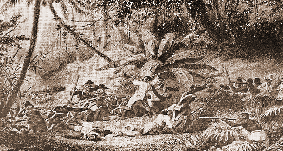 |
Peoples' movements and protests |
 |
|
Mobilizations16-17 century piracyThe slave uprising in HaitiThe Chartists1848The First internationalThe Social Democratic PartyThe Revolutions 1917-19General strike in Hong Kong 1925-26The occupation of FlintThe welfare statePeronismThe boom of the 60s-70s in EuropeSolidarnoscThe metal strike in São PauloThe Hyundai strikeBack to Labour MovementsBack to main page |
The slave uprising in Haiti
The Caribbean sugar plantations were the most successful commercial corporations of the 18th century. They were also England’s and France’s greatest assets in the struggle for world domination. On the plantations worked slaves who were hunted and captured in West Africa. As a rule, the slaves were far too divided and oppressed to be able to put up much resistance beyond the so-called everyday resistance, i.e offering bad work for poor working conditions. It happened that slaves fled and in passing took the opportunity to burn down their masters’ houses. Colonies of escaped slaves were established around the Caribbean that could sometimes last for decades – yes, miskitos in Nicaragua are a community of originally escaped slaves that still exist. It only happened once that slaves rebelled on a large scale. In return, this one time was a decisive contribution to the development of the world. Haiti, or Sainte-Domingue as it was then called, was France’s richest colony, accounting for a third of French foreign trade. There, 400,000 slaves worked on plantations owned by wealthy merchants. Otherwise, there lived 20,000 Europeans who had the political power and as many mulattoes who were economically equal to the Europeans but lacked political rights. When the French National Assembly in 1789 published its proclamation on human rights, the mulattos hurried to demand that the rights also apply to them. Violent triangular battles immediately broke out between mulattoes, European merchants and European artisans. Encouraged by the disagreement among the island’s upper class, the slaves also revolted on five plantations on 22.8.1791. The island’s upper class, who did not dare to hope for revolutionary France for support, appealed to the English military and the Paris government had little choice but to offer the slaves full citizenship if they helped repel the English attack. They did this too (and killed more than half of the English soldiers who fell in the Revolutionary / Napoleonic Wars). Their struggle gained world historical significance in three ways. First, they intimidated the upper class of South America into establishing their own states to prevent similar uprisings on the South American mainland. Second, slavery was abolished within a few generations on American plantations. The upper class realized that paid work was safer. Third, the French bourgeoisie was ruined when the plantations
of Sainte-Domingue were no longer cultivated. This in turn led to
Paris’ artisans
gaining the upper hand in French politics for a few years and having
the time and opportunity to create a revolutionary tradition that
would remain alive for more than a hundred years. Reading
|
